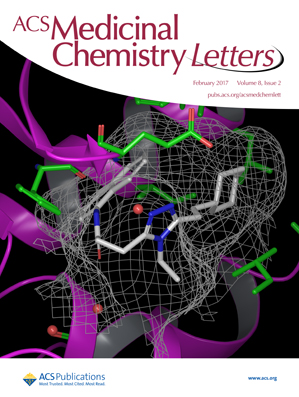选择性PARP1抑制剂治疗癌症的研究进展
IF 4
3区 医学
Q2 CHEMISTRY, MEDICINAL
引用次数: 0
摘要
聚(adp -核糖)聚合酶1 (PARP1)是PARP酶家族的关键成员,在DNA损伤反应中负责大部分聚(adp -核糖)化活性。开发高选择性PARP1抑制剂对下一代癌症治疗至关重要,以减轻抑制其他PARP亚型引起的不良反应。该专利公开的化合物对PARP1的选择性优于PARP2,具有进一步临床研究的前景。本文章由计算机程序翻译,如有差异,请以英文原文为准。
Development of Selective PARP1 Inhibitors for Treatment of Cancer
Poly(ADP-ribose) polymerase 1 (PARP1) is a critical member of the PARP enzyme family, responsible for the majority of poly(ADP-ribosyl)ation activity in response to DNA damage. The development of highly selective PARP1 inhibitors is paramount for next-generation cancer therapeutics to mitigate the adverse effects caused by inhibition of other PARP subtypes. This patent disclosed compounds demonstrate exceptional selectivity for PARP1 over PARP2, which is promising for further clinical research.
求助全文
通过发布文献求助,成功后即可免费获取论文全文。
去求助
来源期刊

ACS Medicinal Chemistry Letters
CHEMISTRY, MEDICINAL-
CiteScore
7.30
自引率
2.40%
发文量
328
审稿时长
1 months
期刊介绍:
ACS Medicinal Chemistry Letters is interested in receiving manuscripts that discuss various aspects of medicinal chemistry. The journal will publish studies that pertain to a broad range of subject matter, including compound design and optimization, biological evaluation, drug delivery, imaging agents, and pharmacology of both small and large bioactive molecules. Specific areas include but are not limited to:
Identification, synthesis, and optimization of lead biologically active molecules and drugs (small molecules and biologics)
Biological characterization of new molecular entities in the context of drug discovery
Computational, cheminformatics, and structural studies for the identification or SAR analysis of bioactive molecules, ligands and their targets, etc.
Novel and improved methodologies, including radiation biochemistry, with broad application to medicinal chemistry
Discovery technologies for biologically active molecules from both synthetic and natural (plant and other) sources
Pharmacokinetic/pharmacodynamic studies that address mechanisms underlying drug disposition and response
Pharmacogenetic and pharmacogenomic studies used to enhance drug design and the translation of medicinal chemistry into the clinic
Mechanistic drug metabolism and regulation of metabolic enzyme gene expression
Chemistry patents relevant to the medicinal chemistry field.
 求助内容:
求助内容: 应助结果提醒方式:
应助结果提醒方式:


